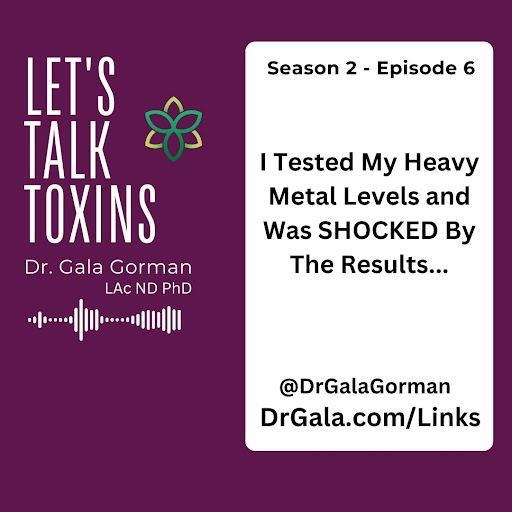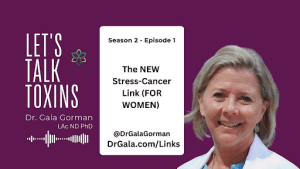NOTE: A machine generated this transcript. Please be aware that it may contain occasional errors in punctuation and spelling.
There’s an unusual heavy metal that has some recent research related to its toxic effects, and this is chromium. Chromium is essential in trace amounts for normal reproductive functions, but it can cause significant health issues when exposure is chronic.
Welcome to the Let’s Talk Toxin Show. Today, we’re going to talk about something that affects all of us but often goes unnoticed: heavy metal toxicity. We’re going to specifically focus on its impact on women over 50, and just know that these toxins are silent intruders in our body.
They cause hidden damage and can disrupt our hormonal balance. If you are concerned about heavy metal exposure and its effects on your health, you’re not alone. In this episode, I’ll share practical strategies for reducing your exposure to heavy metals and detoxing to support your overall wellbeing. Make sure you stay to the end where I answer questions from women just like you.
If you’re new here, I’m Dr. Gala Gorman, a licensed acupuncturist, naturopath, and author of “What’s Your Kryptonite?” I wrote the book to help women understand the effects of chronic stress that’s turned toxic. In the book, I share the MOLT Method™ I developed to make it easy to shed stress along with the accumulated toxicity, just like any other creature in nature that’s outgrown its trappings.
Many women find their way to me after trying everything to deal with their annoying symptoms. You may feel like you’ve learned more than you ever wanted to know about health, and you’re still not healthy. It’s time for a different approach. Symptoms are directly related to stress, but stress isn’t easy to master, and it isn’t going away.
If you’re ready for a new approach that will lead to stress mastery, I highly recommend my Wellness Warriors membership. It’s perfect for those who have a strong sense they’re missing something important—that’s the key to optimal wellness.
In the membership, we apply the MOLT Method™ I developed. MOLT is an acronym: M is for mindset, O is for order, L is for lifestyle, and T is for toxins. It’s designed to help you shed stress, cruise through midlife symptom-free, and end issues like chronic fatigue, insomnia, and even weight gain. Join us and turn your knowledge into real change. You can learn more at drgala.com/links.
In this segment, I share information from research studies related to toxicity. You can think of it as a Toxin Trend. The T in MOLT stands for toxins, and I can say with confidence that every symptom is caused by accumulated toxicity. I evaluate 12 categories of toxicity when I’m working with someone to unravel a health mystery.
Our world is full of manmade substances that our bodies were not designed to deal with. Coupled this toxicity with an overwhelming amount of toxic stressors the body was designed to manage, and it’s no wonder women find themselves playing whack-a-mole with symptoms.
So this is a report that’s a great example of a Toxin Trend. There’s an unusual heavy metal that has some recent research related to its toxic effects, and this is chromium. Chromium is essential in trace amounts for normal reproductive functions, but it can cause significant health issues when exposure is chronic.
Recent studies highlight chromium’s role in genomic instability, oxidative stress, and DNA damage, which are linked to carcinogenic effects, particularly in the lungs, larynx, bladder, and kidneys.
Additionally, chromium exposure has been associated with kidney dysfunction and even skin diseases, which further emphasizes how potentially toxic it is. This recent research also explores chromium’s impact on epigenetic modifications and talks about how it influences gene expression.
I just mentioned that it’s definitely a factor in our reproductive system, but if it’s out of balance, it can lead to reproductive issues like ovarian cysts and even uterine abnormalities. The ongoing research underscores the importance of understanding chromium’s toxic mechanisms to better manage its health impacts.
Some of the forms of chromium—just know that chromium exists in two primary forms: trivalent and hexavalent. Just know that Cr6, or the hexavalent variation, is significantly more toxic and carcinogenic and can cause severe health issues, including lung cancer or, at a minimum, respiratory irritation and kidney damage.
In contrast, Cr3 is generally less toxic, but it can still cause oxidative stress and reproductive issues if you’re being exposed to it at high concentrations. So, chromium tends to be one of the things that we take for helping to balance our minerals. But just keep this in mind when you’re taking any sort of supplement that it is definitely an issue that we can create more problems than we solve by supplementing with single things, particularly when we’re supplementing with one single mineral and then create an imbalance.
Some of the health effects and how exposure happens: it typically occurs with inhalation. It is possible that you could ingest it unknowingly—that’s less likely—but it’s also possible to come into contact with it through your skin. Again, we’ve talked about some of the health effects, including respiratory problems, asthma, cough, skin ulcers, and ultimately an increased risk of cancer.
Just remember that not every form of chromium is the same, and if you’re being exposed or even ingesting the less toxic form of chromium at lower levels, as long as you have really put some thought into what you’re doing and why, and you’re monitoring the kinds of symptoms that we’re talking about here, it’s probably not going to create a problem.
But it’s really important, and I wanted to bring this to your attention because I think it’s important to know that heavy metal toxicity is not just limited to some of the things that we automatically think about, like mercury and that sort of thing.
Again, you can have any sort of respiratory irritation. They’re even saying potentially nasal ulcers. And then we talked about reproductive issues and even infertility. Before you seek fertility treatment, you want to make sure that you really have things in balance and that you’re healthy. Otherwise, that’s the approach that an oriental medicine practitioner like myself would take, potentially saving you many thousands of dollars by avoiding fertility treatment.
Both forms of chromium can affect reproductive health, but we’ve already talked about the type that is more potent. This is the one that really creates a problem and increases the risk of genetic disorders. Chromium toxicity has also been known to cause oxidative stress. This is just something that we don’t want to add any more toxic stressors to our body. We’ve got plenty of exposure in all the things we come into contact with. So, being careful to manage your chromium exposure will go a long way to take care of your overall health and wellbeing.
Chapter 12 in my book, “What’s Your Kryptonite?”, is dedicated to helping readers manage what I refer to as Tricky Toxins. Our bodies are bombarded with toxicity, so we have to learn to manage it. Just comment “tricky toxins,” and we’ll send you a link where you can download the chapter for free. If commenting isn’t convenient, go to drgala.com/links and sign up for my Wellness Weekly newsletter. You can respond to any email you receive from me with “tricky toxins,” and we’ll send you a link.
In this next segment, I’m opening the kimono to share how I was challenged to apply my suggestions. I’m Walking My Talk, and here’s an example. Every suggestion you’ll hear from me has been tested in the trenches. That includes saying no to symptom suppression. Over the past four decades, I’ve developed processes that work sustainably. Typically, it requires a combination of approaches that I’ve synthesized to address the health issues that show up repeatedly for many women.
I had an opportunity to walk my talk where this heavy metal exposure is concerned. Here’s what I want to share with you. I use a bioenergetic scanning system, and it is looking for energetic disturbances. I evaluate 12 categories of toxicity, and heavy metals is one of those categories. On the scan, it showed that heavy metal toxicity was creating an energetic disturbance for me. I could have just put myself on some sort of detox, particularly targeted to heavy metals, but I was curious to see if this would actually show up in a lab test.
I had a lab test done. Typically, we use urine to test for heavy metals. It was fascinating. While you would normally assume that it was mercury that was creating the problem, in my particular case, mercury was one of the issues, but it was not the main issue.
The actual problem was beryllium. I had never even heard of beryllium at this point, so I was fascinated to dig into this. This is common for people who are working with technology a lot, which I do. I’m in front of screens. I’ve been working with technology since I was in my early twenties.
It’s common to get off-gassing from the components they put into this technology. What I really learned here is that there are lots of possibilities, so you can’t just assume that you can stop eating fish and it’s going to solve the problem.
The other thing is that heavy metals are really problematic to pull out of the body. You’ve got to be very careful, and you need to use a targeted detox to get that done. So it’s important to know what you’re actually dealing with.
I also learned that my scan is accurate, but lab tests are also beneficial sometimes because they fill in the details. I will say that lab tests tend to be extremely expensive, so we only turn to a lab test when we feel like we need to dig deeper and understand what’s going on. I will also tell you that with my particular technology for bioenergetic testing, I get information that is not available from any lab tests.
So, from my perspective, the scan is the first stop, and the lab test provides detail when we feel like we need more detail.
Mitigation is important. As I mentioned, you’re going to do some sort of detoxing. In this particular case, I used a protocol that I designed specifically for this purpose. It’s important not to just use some random detox and think it’s going to solve the problem. Most importantly, you want to reduce your exposure.
I’ve worked hard to increase my mitigation efforts, using more protection and reducing my exposure, doing a better job of grounding, stepping away, that sort of thing. Then, you want to monitor your improvement and make sure that what you’re doing is working. I do that on a regular basis as well. So, hopefully, that helps you understand how I would manage a situation when a high level of toxicity shows up.
Let’s continue talking about a hidden health concern that affects many of us, this heavy metal toxicity, and how it’s silently impacting our health, especially during midlife. Understanding the risks of heavy metals is crucial as these toxins can have profound effects on our wellbeing.
Symptoms related to having metal toxicity often mimic other conditions, making it really challenging to diagnose the actual root cause of the problem. While we can’t completely eliminate exposure to heavy metals, the good news is that we can take practical steps to reduce our risk and support our body’s natural detoxification mechanisms. We’re going to look at recent research and evaluate what it’s telling us about managing heavy metal exposure and maintaining optimal health during midlife and beyond.
How do women encounter heavy metals every day? Well, heavy metals enter your body through tap water, food, especially fish and rice, makeup, air pollution, and cigarette smoke. Most women get exposed primarily through their diet and household products.
If you want to get tested for heavy metals and you don’t have access to using my bioenergetic scanning system, there are blood tests or urine tests that will show recent exposure to metals like lead and mercury. You can also use hair tests but hair tests are going to reveal longer-term exposure.
So if you’re concerned that you may have had recent exposure, then you can use something like a blood or urine test. But if you want to really evaluate how long this exposure has been going on, you’re going to want to use hair because then they’re going to be able to tell essentially where it’s showing up in your hair that’s grown out.
Your doctor can help determine the test that’s right for you. And unlike other toxins that you might be able to detox more easily, heavy metals will not easily leave your body. They accumulate over decades, which is why many women, by the time we get to midlife, have higher levels, even when we have pretty low consistent exposure.
Heavy metals definitely disrupt our hormone system. They’re essentially acting like an uninvited guest at a party. They disrupt your body’s hormone messaging system. So this kind of mimics hormones, blocking the hormone receptors, or it could interfere with how your body produces hormones.
Lead, for example, can lower your estrogen while raising FSH levels, worsening your menopause symptoms. Honestly, any kind of stress can do this, but the toxic stress from heavy metals is certainly a way this can happen.
Mercury can affect the proteins that transport hormones in your bloodstream and create further imbalances. If you go beyond estrogen, metal exposure can create estrogen dominance. This can cause PMS, weight gain, and painful periods. So you can see that if you have been exposed to metals and you’re having these kinds of issues earlier in life, it’s definitely not too early to check your toxicity levels.
These metals can simultaneously deplete other minerals that are needed in your body to produce healthy testosterone levels. And so this can lead to fatigue and even brain fog. Heavy metals can also affect reproductive health.
Women with higher levels of metals like cadmium and mercury show lower AMH levels. This is a marker of how many eggs remain in your ovaries, and this effect is even stronger than the impact of smoking. So don’t think that you are safe if you’re a non-smoker or if you’re not around smoking. Know that there are other ways that this toxic buildup can affect your fertility.
Your reproductive system ages more quickly with metal exposure. Studies show women with higher cadmium levels experience up to 9% faster decline in ovarian reserve markers every year. Heavy metals can damage egg follicles, potentially triggering earlier menopause and its associated health challenges. This includes menopausal symptoms like hot flashes, even a risk of heart disease or osteoporosis.
Remember, you can get the “Tricky Toxins” chapter of my book “What’s Your Kryptonite?” for free. Just comment “tricky toxins,” and we’ll send you a link where you can download the chapter. If commenting isn’t convenient, go to drgala.com/links and sign up for my Wellness Weekly newsletter. You can respond to any email you receive from me with “tricky toxins,” and we’ll send you a link.
Now, let’s continue with a few practical ways to address the risks of long-term unmanaged heavy metal toxicity and how it affects more than just our physical health. It can actually impact our overall wellbeing and increase our risk of various complications during midlife, but there is some good news.
Even small changes in our daily routines can significantly reduce our exposure to heavy metals and support our body’s natural detoxification mechanisms. And don’t forget, when I’m done, drop a comment to share which detox tips you are planning to try and why you think they’ll work best for your health journey.
Let’s take a quick look at some of the health risks from heavy metal exposure. This was particularly lifted out of research that I did for this episode.
Women with higher cadmium levels have nearly double the risk of osteoporosis. These metals weaken bones by interfering with the bone-building cells and the mineralization process. Maybe you are concerned more about your heart or your brain.
Metal exposure increases your risk of heart problems and memory issues. Even low levels can affect blood pressure and make thinking less clear over time. It also will worsen menopause symptoms. We talked about this a few moments ago, Hot flashes, night sweats, mood changes.
All of these symptoms might be more severe with metal exposure because these toxins amplify the hormone fluctuations that are already happening during menopause. So, as promised, here are some strategies for detoxing from heavy metals. Here are some simple daily changes that you can implement that will go a long way to reducing your daily ongoing exposure.
First, you want to make sure that you are filtering your drinking water. I recommend that you use reverse osmosis. A three-stage system is best. Use reverse osmosis water for pretty much everything that you’re drinking.
If you don’t have the ability to install a reverse osmosis system or a high-quality filtration system, then you’re going to need to buy spring or distilled water for your drinking. That can really make a big difference. Don’t trust when they tell you that the drinking water is safe; you’re still going to get toxic metal buildup over time.
Choose low-mercury fish. I will admit I absolutely love tuna fish, and this is something that I eat sparingly now because of the potential buildup of the metals in my body. Make sure you’re washing produce thoroughly. If you haven’t done this already, avoid smoking, and this includes vaping.
You do not want to be getting exposed to these carcinogenic toxins that are coming from smoking regular cigarettes or vaping. Small changes in your daily routine can significantly reduce new metal exposure.
Some of the more helpful foods that will help your body to remove the metals naturally are garlic, onions, cilantro, dark leafy greens in your diet will help promote the pulling out of these metals from wherever your body has stored them.
Foods rich in sulfur and other antioxidants can also support your body’s detox pathways, and that’s definitely going to help. If you really need some support with this. You want to make sure that you are talking to somebody who understands how to deal with toxicity, particularly metal toxicity, and can advise you on testing options and help you to create a personalized, customized detox plan.
The right approach depends on your specific exposure history, health needs, and what else you’ve got going on in your current situation.
The answers I give to questions I receive quite often apply to and would be helpful for most women. I’ve accumulated a few related questions, and I’ll answer them in this segment. I call it “Ask Away.” If you’d like to ask a question, I created a form so that it’s sure to get answered, and your question could be shared in a future episode, helping many other women. So, comment “question,” and we’ll get you a link to the form. If commenting isn’t convenient, go to drgala.com/links and sign up for my Wellness Weekly newsletter. You can respond to any email you receive from me with “question,” and we’ll send you a link.
How does heavy metal toxicity affect menopause?
Well, heavy metals like lead and mercury can disrupt hormone levels, potentially worsening menopause symptoms like hot flashes and mood swings. Exposure to heavy metals has been linked to earlier arrival of menopause and a reduced ovarian reserve.
Managing heavy metal exposure can really go a long way to alleviate some of these menopausal symptoms. I will say, though, that any sort of stress from any of the toxic stressors that I talk about on the Let’s Talk Toxin Show will actually contribute to making menopause symptoms worse. So, I really encourage that you go back and watch the whole episode and consider what other ways you are introducing too much stress into a system that’s already stressed, trying to manage the transition into menopause.
What are common sources of heavy metal exposure?
For starters, contaminated water is one of the most common ways, and many of us are still consuming tap water. Just know that that is not a great strategy. You want to definitely uplevel the quality of water that you’re consuming.
Hydration is critically important for your health. It’s one of the things that our body needs to make energy. So, don’t think you can just consume less water. You need to be consuming 60 to 100 ounces of water every day, but it needs to be high-quality water. This is also going to help to flush out any of the metals that have accumulated in your body over time.
Metals also come in through polluted air. I always recommend a high-quality air purifier. Certain foods like fish tends to have mercury and that sort of thing. So, we want to make sure that we’re consuming foods that are clean and that we use variation.
One of the foods I love is tuna fish, but I try to eat that sparingly because it’s a known source of mercury. Definitely want to limit your exposure to that as much as possible. It’s also known that these kinds of metals can be in cosmetics, so you want to make sure that you’re using really clean cosmetics lines.
And then, poorly coated dinnerware or cookware is also another source. So, you really need to make sure that you’re using high-quality cookware, preferably something like stainless steel, and that will help to reduce your ongoing exposure as well.
We don’t come into it very often anymore, but old lead paint from the 60s can be a cause for concern. As an oriental medicine practitioner, I will say that if you’re sourcing herbal medicines from lower-quality sources, some of these herbs can have high levels of heavy metals in them.
So, it’s just really important to know where you’re sourcing your ingredients, read the labels, and if you want to really understand some of the other things that I look for and what I recommend for you to mitigate the impact of heavy metals, you want to make sure you watch the whole episode.
How can I reduce my exposure to heavy metals?
Well, first, you want to avoid foods that are known to be contaminated, certain kinds of fish, but also rice. Rice is one of the things that is really known to have high levels of metal toxicity. So, you definitely want to buy organic rice, or any type of grain should be organic.
That isn’t a hundred percent going to eliminate your risk, but minimizing the amount of fish that you’re consuming, especially the types of fish that are known to be high in metal toxicity, or making sure that you’re using organic grains, in particular, rice.
Use filtered water, and I recommend a reverse osmosis, three-stage filter. If you cannot consume filtered water easily, you’re going to need to buy water, and that is spring or distilled water. You need to be drinking 60 to 100 ounces of water every day. Not having access to high-quality water is not an excuse for drinking less water.
We need to be flushing these toxins out of our body. Our body uses water, the hydration to make energy. Staying hydrated with high-quality water is going to go a long way towards your overall health and wellbeing efforts.
Also, you want to make sure you limit the use of products that are known to have heavy metals. These includes some types of cosmetics. So, you want to make sure that you’re reading those labels and being mindful of where you are potentially getting exposure from.
What are the symptoms of heavy metal poisoning?
Well symptoms can include confusion, numbness, nausea, and abdominal pain. Long-term exposure can even lead to kidney damage or liver issues. Because remember, your liver and kidneys are the main organs that are trying to eliminate these toxins. Understandable if you’ve really got a heavy toxic load, these organs are overworking, and overworking anything is not good for it, right? So that makes sense.
It’s also possible to have cognitive problems, and there’s been research that’s shown signs of metal toxicity correlated with Alzheimer’s in the brain. We really can’t do any sort of research until after someone has passed from one of these conditions. So you don’t want to wait to have this determined after the fact.
You want to be mitigating your exposure and taking care of your health while you are still here and can. Severe cases of metal exposure can definitely be life-threatening conditions.
Is it possible that my memory loss and confusion are related to heavy metal toxicity?
Memory loss and confusion can be symptoms of chronic heavy metal exposure. Absolutely! Particularly to metals like lead and mercury, which affect brain function. In fact, this is one of the things that led us to eliminating the use of lead-based paint.
The symptoms might also be related to hormonal changes during menopause, but heavy metals can make these cognitive issues worse. If you really think this is a problem for you, it’s important to talk to a professional that can help you determine what type of testing is appropriate for your particular situation and suspected heavy metal exposure.
Could heavy metal toxicity be causing my joint pain and fatigue?
Joint pain and fatigue are common symptoms of chronic heavy metal exposure. Metals like cadmium and lead can cause inflammation and oxidative stress. These symptoms might also be related to menopause or other health conditions, but heavy metal toxicity should be considered as a potential factor.
A thorough evaluation should be done by somebody who is an expert in dealing with metal toxicity to really determine if heavy metals are the likely root cause of some of the issues that you may be experiencing. If you’re wanting more information and detail related to this, then I would encourage you to watch the whole episode.
Remember, if you’d like me to answer your specific question, make sure to comment “question,” and we’ll send you a link to the submission form. You’ll want to subscribe to the channel notifications to get regular updates, and that’s a wrap for this episode. This has been the Let’s Talk Toxins Show. Make sure you subscribe to my channel on YouTube and activate the notifications. You’ll get a reminder when I’m going live next. Until then, be well.













